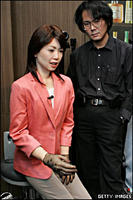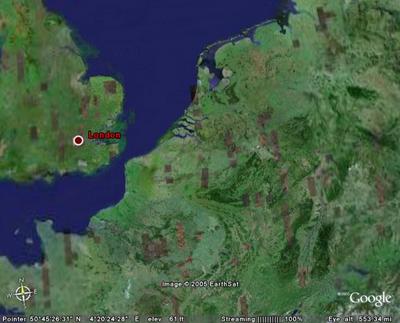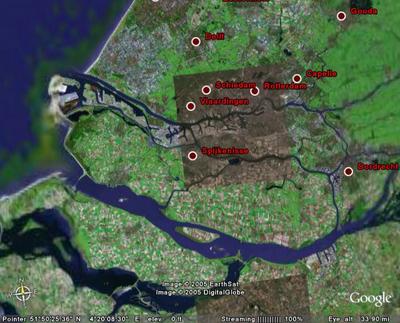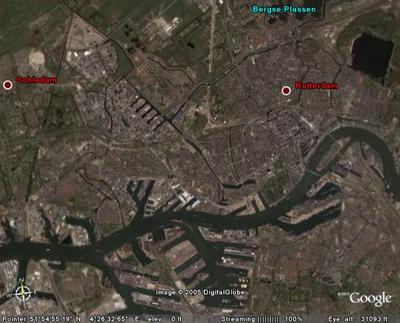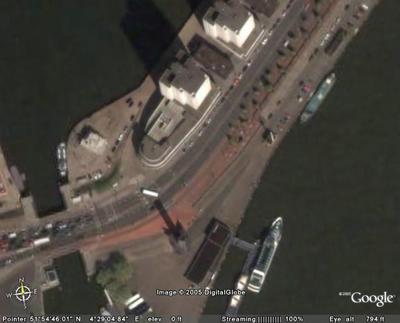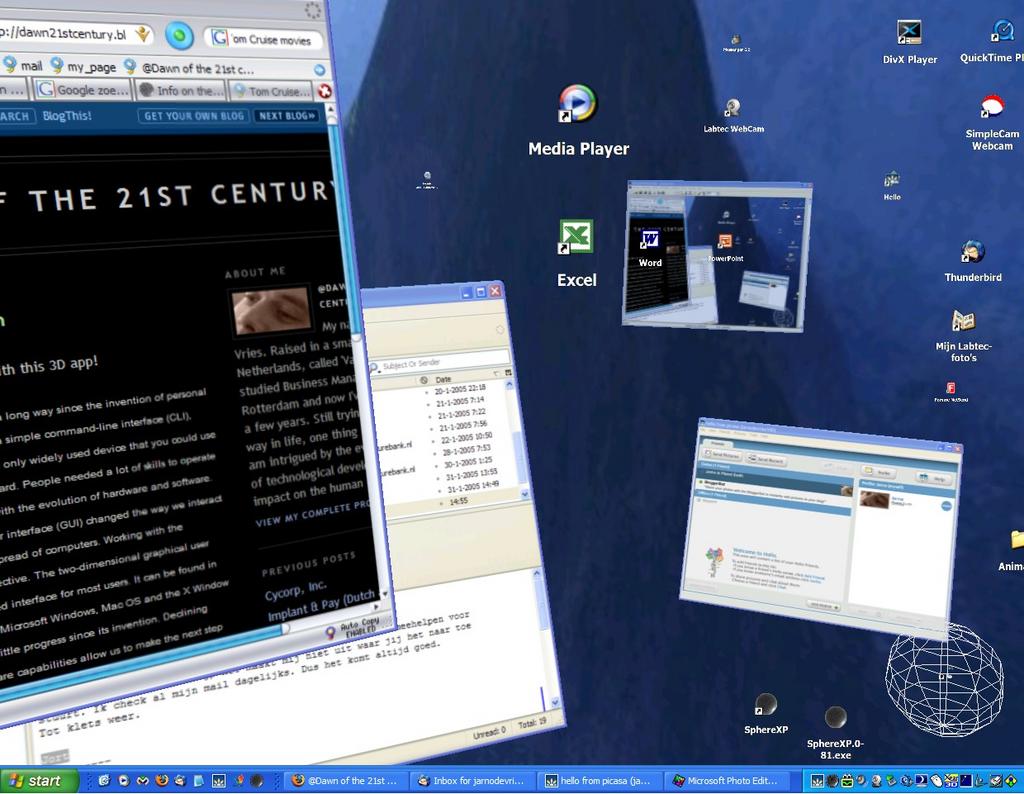zaterdag, juli 30, 2005
donderdag, juli 28, 2005
Fiber Optics Bring the Sun Indoors
 The HSL 3000, a hybrid lighting system developed by Sunlight Direct, carries the actual light of the sun indoors. The system’s 48-inch primary mirror concentrates light into a secondary mirror, which strips away the infrared and ultraviolet components, and directs the visible light into the receiver
The HSL 3000, a hybrid lighting system developed by Sunlight Direct, carries the actual light of the sun indoors. The system’s 48-inch primary mirror concentrates light into a secondary mirror, which strips away the infrared and ultraviolet components, and directs the visible light into the receiver“When you come in, in the morning and you’re tired, and you’ve got your coffee in your hand and you’re not quite awake, you like seeing the reddish glow… the same type of light as outside.” Dr. Duncan Earl, CEO of Sunlight Direct, explained the psychological appeal of his company’s hybrid lighting system to the Canadian Discovery-Channel’s host Jay Ingram. People are more comfortable “waking up with the sun” and as the light becomes white they work through the day. “And at the end of the day when there’s a reddish glow, you know it’s time to go home.”
woensdag, juli 27, 2005
FUTURES MARKET
Very interesting article here about a Technology Timeline compiled by researchers at BT's futurology department with a list of advances they say will change tomorrow's world. Here's some of what they predict:
(2006-2010) Emotionally responsive toys, Electronic medical prescription, Video tiles (2008-2012) Medicine delivered via fruit, Video tattoos, Sensitive fabrics (2011-2015) Self-driving car, Tooth regeneration, Microchips in food (2013-2017) Active make-up, Robots guide blind people (2016-2020) Electronic lifeform gets basic rights, Viewers play film roles, Emotion control devices (2021-2025)
E-translation, Holographiv TV (2026-2030) 3D home printers (2031-2035) Biostasis in space travel, Computer geniuses
(2006-2010) Emotionally responsive toys, Electronic medical prescription, Video tiles (2008-2012) Medicine delivered via fruit, Video tattoos, Sensitive fabrics (2011-2015) Self-driving car, Tooth regeneration, Microchips in food (2013-2017) Active make-up, Robots guide blind people (2016-2020) Electronic lifeform gets basic rights, Viewers play film roles, Emotion control devices (2021-2025)
E-translation, Holographiv TV (2026-2030) 3D home printers (2031-2035) Biostasis in space travel, Computer geniuses
dinsdag, juli 26, 2005
Computer scientists to copy brain of a mammal
Read the article here
'IBM and Switzerland's Ecole Polytechnique Federale de Lausanne (EPFL) have teamed up to create the most ambitious project in the field of neuroscience: to simulate a mammalian brain on the world's most powerful supercomputer, IBM's Blue Gene.
Most theoretical neuroscientists have tried to simulate the brain using artificial neural networks. "That is not our goal," says Henry Markram, the professor leading the project. Markram wants to simulate the brain at every level of detail, even going down to molecular and gene expression levels of processing. At EPFL's Brain and Mind Institute, every facet of the brain is being examined and modelled'
'IBM and Switzerland's Ecole Polytechnique Federale de Lausanne (EPFL) have teamed up to create the most ambitious project in the field of neuroscience: to simulate a mammalian brain on the world's most powerful supercomputer, IBM's Blue Gene.
Most theoretical neuroscientists have tried to simulate the brain using artificial neural networks. "That is not our goal," says Henry Markram, the professor leading the project. Markram wants to simulate the brain at every level of detail, even going down to molecular and gene expression levels of processing. At EPFL's Brain and Mind Institute, every facet of the brain is being examined and modelled'
Furby is back and THIS TIME...
 ... he's gotten really smart. Furby will hit the market in a few weeks now, his manufacturer says (or should I say his mom/dad).
... he's gotten really smart. Furby will hit the market in a few weeks now, his manufacturer says (or should I say his mom/dad).Wanna know what Furby can do?
Well, he can laugh, smile, frown, gasp, yawn and express fear or boredom using its flexible beak, expressive eyes, and movable ears & eyebrows. All this driven by Hasbro's new Emoto-Tronics technology, a combination of advanced robotic technology, puppetry and realistic lifelike reactions and movements.
Since Furby also has a light sensor, a tilt sensor and several touch sensors, his response to you really depends on how you handle him. The touch sensors can be found in his back, mouth and stomach, so petting, feeding and tickling makes a real difference. But of course, that's not all..
Using advanced voice recognition, Furby listens to you and talks back. So he can tell you all kinds of stories since he has an impressive vocabulary of both 'Furbish' and English, but you can also ask Furby to tell you a joke for instance and he'll most likely deliver a knock-knock zinger. Of course, his response depends on his 'mood'.
He also recognizes other Furby's in his vicinity and did I mention that he can dance and sing?
And you know what the bizarre thing is? Furby costs $39.99! So far I have no idea when and at what prize it will be available in Europe, so I keep track of these guys, cause they ship worldwide.
maandag, juli 25, 2005
Want Virtual Reality in Google Earth?
The boys and girls at Berkeley university have created this huge database of VR-panoramas.
This German guy, Thomas Rauscher, has been so nice as to create a bookmarklist for Google Earth that links to the Berkeley-database..
So, if you have Google Earth, download this kmz.file and get VR-panoramas like this in your GE (this one happens to be the exact beach at Pulau Tioman, Malaysia, where I went for 3 weeks in 2002 and learned how to dive >> so with a small tear in my eye I say: Google, Berkeley and German dude, thank you!)
Oh, and don't forget to check out the Google Earth Community
This German guy, Thomas Rauscher, has been so nice as to create a bookmarklist for Google Earth that links to the Berkeley-database..
So, if you have Google Earth, download this kmz.file and get VR-panoramas like this in your GE (this one happens to be the exact beach at Pulau Tioman, Malaysia, where I went for 3 weeks in 2002 and learned how to dive >> so with a small tear in my eye I say: Google, Berkeley and German dude, thank you!)
Oh, and don't forget to check out the Google Earth Community
A.I. based bionic knee hits market
Thought this was a nice one..
'What makes the Rheo-Knee different is that it's the first to use artificial intelligence -- tiny sensors that analyze the knee 1,000 times per second allowing it to adjust to any step or misstep'
By the way: It costs $30.000, you can watch the 3D-video here & download the official brochure (pdf) here
By the way 2: The term Bionic describes the application of biological principles to the study and design of engineering systems, especially electronic systems - Bi(o) + (electr)onics.
'What makes the Rheo-Knee different is that it's the first to use artificial intelligence -- tiny sensors that analyze the knee 1,000 times per second allowing it to adjust to any step or misstep'
By the way: It costs $30.000, you can watch the 3D-video here & download the official brochure (pdf) here
By the way 2: The term Bionic describes the application of biological principles to the study and design of engineering systems, especially electronic systems - Bi(o) + (electr)onics.
zaterdag, juli 23, 2005
One-atom-thick materials promise a 'new industrial revolution'
Boy, do I love this nanotech-stuff! This one is pretty serious though: Scientists at The University of Manchester have discovered (The findings were published 18 July, 2005) a new class of materials which have previously only existed in science fiction films and books.
Dr Kostya Novoselov, a key investigator in this research, said "Although some of the applications are probably decades away, I expect to see ultra-fast transistors, micromechanical devices and nano-sensors based on the discovered one-atom-thick crystals already in a few years time."
In this regard, you might wanna check out the posting I uploaded last week 'From Sticks & Stones to Nanotech!'; gives you a nice overview of what's going on..
Dr Kostya Novoselov, a key investigator in this research, said "Although some of the applications are probably decades away, I expect to see ultra-fast transistors, micromechanical devices and nano-sensors based on the discovered one-atom-thick crystals already in a few years time."
In this regard, you might wanna check out the posting I uploaded last week 'From Sticks & Stones to Nanotech!'; gives you a nice overview of what's going on..
vrijdag, juli 15, 2005
Are you Vlogging yet?
No? Then quickly check out the links below (or look at the right side of this blog for some video-blogs straight from the videoblogging-universe, move the mouse over the 'pictures' and they will turn into video..). Did I mention that I love this stuff?
Popcast - Open Access Internet TV
Broadcast Machine
Vlogdir - The Videoblog Directory
Popcast - Open Access Internet TV
Broadcast Machine
Vlogdir - The Videoblog Directory
Hold on to your horses cause the future is coming!
 Wanna know what the 2 screenshots below are all about?
Wanna know what the 2 screenshots below are all about?Thank you soo much John Smart @Accelerationwatch.com, cause finally I can put my finger on this awkward feeling I've had for the past 20 years... (No, no, I'm 31 springs young, but the first 11 were quite harmless)
'You've felt it your entire life, that there's something wrong with the world.
You don't know what it is, but it's there, like a splinter in your mind...'

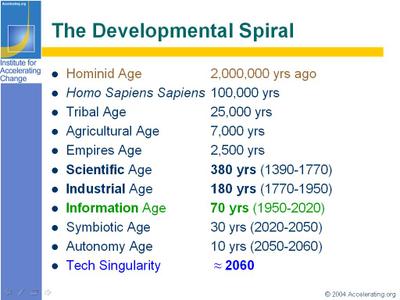
donderdag, juli 14, 2005
Startup Deep Light claims to have multiplexed 3D HDTV

Bla bla marketing, or will they actually be close? I definitely hope so, cause ever since I've seen this holographic shark in the movie 'Back to the future II', I've been waiting. And I'm still waiting!!! Just recently I posted this piece on Philips' 3D ambitions, so at least it seems things are cooking in the kitchen, but when it is that mommy really calls in the children for dinner.... who knows ... let's just hope the food doesn't get burned this time.
Philips ready to start selling 3D-screens by October
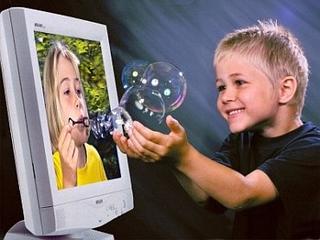
In a press briefing yesterday, Philips announced that they'll be ready to start selling their new 'Multi-view' 3D-screen by October this year (not yet to the end-consumer though). They've had talks with Steve Wynn for instance. Dude? Steve Wynn? Yeah, dude man! He's the guy behind Treasure Island, Mirage and Bellagio in Vegas. He's thinking 3d-screen equipped gambling machines; good for business you know. And what about Killzone II for the Playstation 3, in 3D! (well, that's just my own little fantasy).
Anyway, before I get overly excited again, let's finish up this post >>
Here's the link :) :)
By,
Jarno
woensdag, juli 13, 2005
From Sticks & Stones to Nanotech!
After a few billion years of evolution on this planet, about 150.000 years ago nature had finally completed 'the design' (evolutionary development) of what we so proudly call today: Homo Sapiens Sapiens. Monkeys had already figured out that you could chase any competition away by throwing sticks & stones at eachother. We (well, the hominids right before us, to be exact) however managed to figure out that if you would bang two stones on top of eachother long enough, you could actually change the shape of these stones. And this is how the 'manufacturing process' of sharp edges started. Very useful, cause it enabled us to more effectively kill animals (so we could survive using less effort).
And this is how the story begins. From there on we basically embarked on a path of ever more effective 'manipulation' of the environment (the basic essence of survival for us); shaping tools and building stuff, basically.
Essentially our approach to building stuff has never really changed, we still use a Top-Down approach; take a house for instance: we literally stack layers and layers of bricks on top of eachother.
Now, @dawn of the 21st century, we have also learned that things are much smaller than they seem @first glance: atoms are the basic building blocks of everything, Barbie-dolls, sigarettes, humans, we're all nothing more than an intricate system of trillions of atoms..
Obviously we could build things much better if we would be more precise, if we would use a Bottom-Up approach instead of a Top-Down approach; if we could figure out a way of building something by doing it atom-for-atom, we could literally make things perfect - upon returning to Earth, astronauts wouldn't have to worry about part of their spacecraft's heatshield to 'let go', McDonald's wouldn't have to worry about strange stuff popping up in their Burgers and I wouldn't have to sit here writing in my naked upperbody, because 90 degrees or not, the sweat just wouldn't stick to my shirt! - And so on and soforth, because every single atom would 'know it's place'.
So to cut a long story short: Molecular Manufacturing is the Future, a not-too-distant one too. And I think that's cool! And I'm not the only one. The only reason I'm all excited about this, is this guy, Eric Drexler. Back in 1986 he wrote this book 'Engines of Creation', in which he explained the powerful potential of Nano-Technology.
Although the Top-Down approach still is the dominant one when it comes to building stuff, things have indeed already gotten a lot smaller. Just look at the way medicine is being produced, or IBM's carbon nanotubes, or RFID-chips (and Smart Dust shortly thereafter), or, and many more examples...
As exciting as things have already gotten, we haven't even begun to touch upon the true power of the Nanotech age though. Because in a truly developed nanotech-society we would have 'factories in a box' (literally). All you need would be a 'pool of basic goo' (containing all required atoms) and a factory so small you can't see it, that would 'put every required atom in the right place, at lightspeed. And then you're in the realm of Star Trek where you can tell the computer what food you want and it would be produced instantly (from our very very large Top-Down human perspective).
Would this be possible? Yes! Yes! Yes! But it obviously sounds ridiculous to most people anyways, just like lightbulbs, phones (yes even fixed-line phones :), cars, airplanes, computers, nuclear bombs, the Internet and all these other things sounded ridiculous 200 years ago.
But, do not worry Oh fellow-earthlings! Welcome to the age of limitless visualization! What? Well, animator and engineer, John Burch, and pioneer nanotechnologist, Dr. K. Eric Drexler have now completed a new computer-generated animated short film called "Productive Nanosystems: from Molecules to Superproducts".
So get ready to enjoy: The future of Manufacturing (60+ MB)
Read more about Nanotech here! (thanx to the British government)
With kind regards and shitloads of love,
Yours truly,
Jarno
And this is how the story begins. From there on we basically embarked on a path of ever more effective 'manipulation' of the environment (the basic essence of survival for us); shaping tools and building stuff, basically.
Essentially our approach to building stuff has never really changed, we still use a Top-Down approach; take a house for instance: we literally stack layers and layers of bricks on top of eachother.
Now, @dawn of the 21st century, we have also learned that things are much smaller than they seem @first glance: atoms are the basic building blocks of everything, Barbie-dolls, sigarettes, humans, we're all nothing more than an intricate system of trillions of atoms..
Obviously we could build things much better if we would be more precise, if we would use a Bottom-Up approach instead of a Top-Down approach; if we could figure out a way of building something by doing it atom-for-atom, we could literally make things perfect - upon returning to Earth, astronauts wouldn't have to worry about part of their spacecraft's heatshield to 'let go', McDonald's wouldn't have to worry about strange stuff popping up in their Burgers and I wouldn't have to sit here writing in my naked upperbody, because 90 degrees or not, the sweat just wouldn't stick to my shirt! - And so on and soforth, because every single atom would 'know it's place'.
So to cut a long story short: Molecular Manufacturing is the Future, a not-too-distant one too. And I think that's cool! And I'm not the only one. The only reason I'm all excited about this, is this guy, Eric Drexler. Back in 1986 he wrote this book 'Engines of Creation', in which he explained the powerful potential of Nano-Technology.
Although the Top-Down approach still is the dominant one when it comes to building stuff, things have indeed already gotten a lot smaller. Just look at the way medicine is being produced, or IBM's carbon nanotubes, or RFID-chips (and Smart Dust shortly thereafter), or, and many more examples...
As exciting as things have already gotten, we haven't even begun to touch upon the true power of the Nanotech age though. Because in a truly developed nanotech-society we would have 'factories in a box' (literally). All you need would be a 'pool of basic goo' (containing all required atoms) and a factory so small you can't see it, that would 'put every required atom in the right place, at lightspeed. And then you're in the realm of Star Trek where you can tell the computer what food you want and it would be produced instantly (from our very very large Top-Down human perspective).
Would this be possible? Yes! Yes! Yes! But it obviously sounds ridiculous to most people anyways, just like lightbulbs, phones (yes even fixed-line phones :), cars, airplanes, computers, nuclear bombs, the Internet and all these other things sounded ridiculous 200 years ago.
But, do not worry Oh fellow-earthlings! Welcome to the age of limitless visualization! What? Well, animator and engineer, John Burch, and pioneer nanotechnologist, Dr. K. Eric Drexler have now completed a new computer-generated animated short film called "Productive Nanosystems: from Molecules to Superproducts".
So get ready to enjoy: The future of Manufacturing (60+ MB)
Read more about Nanotech here! (thanx to the British government)
With kind regards and shitloads of love,
Yours truly,
Jarno
dinsdag, juli 12, 2005
The Filtered Future
The Filtered Future - China's bid to divide the Internet.
The Americans wage wars in their pursuit of Democracy on the one hand, but in China on the other, Google doesn't even show articles about democracy and Microsoft also recently admitted that its Chinese blog site would block titles like "freedom" and "democracy,". With a market potential of over a billion consumers, you wouldn't want to piss off the Chinese government, now would you?
The Americans wage wars in their pursuit of Democracy on the one hand, but in China on the other, Google doesn't even show articles about democracy and Microsoft also recently admitted that its Chinese blog site would block titles like "freedom" and "democracy,". With a market potential of over a billion consumers, you wouldn't want to piss off the Chinese government, now would you?
How Earth-Scale Engineering Can Save the Planet
This article presents some quite far-reaching ideas on how to counteract the effects of global warming (mirrors in space, nanobots in the air and soforth)
zondag, juli 10, 2005
We need Water! >> desalination - current situation and future prospects
I personally find this an interesting article. It's about 'the world situation concerning the production, processes, technologies and costs of desalination (taking salt out of water). Experience accumulated worldwide and in Israel enables the forecasting of developmental trends, namely, a continuation of cost reduction, when Israel will enter the era of large-scale desalination'.
I find it interesting to monitor technologies like these because the biggest challenge of our generation will be the question of how to sustain our current way of life, given the declining availability of resources (oil, water, etc.) on the one hand, and growing demand for these resources on the other.
Besides the question of how to secure access to much needed resources, there's the question of how to counteract the effects of using those resources (global warming, etc.). It's nice that we have the Kyoto Protocol, but we'll probably need a hell of a lot more to counter the effects of global warming and soforth.
I find it interesting to monitor technologies like these because the biggest challenge of our generation will be the question of how to sustain our current way of life, given the declining availability of resources (oil, water, etc.) on the one hand, and growing demand for these resources on the other.
Besides the question of how to secure access to much needed resources, there's the question of how to counteract the effects of using those resources (global warming, etc.). It's nice that we have the Kyoto Protocol, but we'll probably need a hell of a lot more to counter the effects of global warming and soforth.

